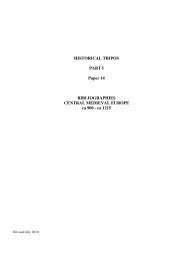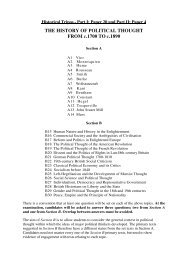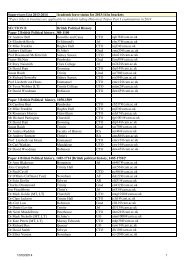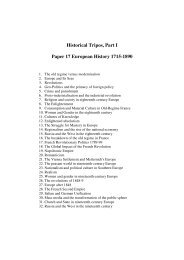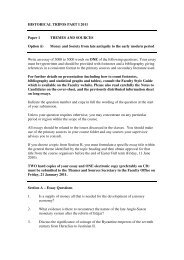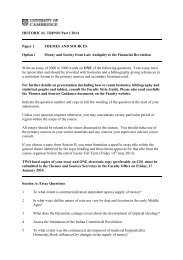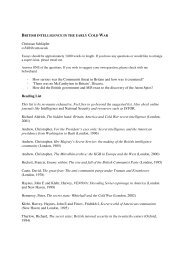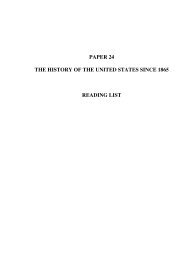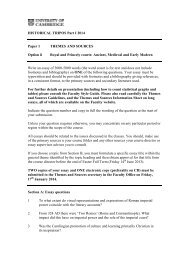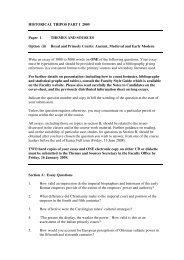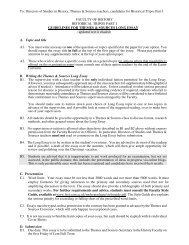Course Handbook - Faculty of History - University of Cambridge
Course Handbook - Faculty of History - University of Cambridge
Course Handbook - Faculty of History - University of Cambridge
You also want an ePaper? Increase the reach of your titles
YUMPU automatically turns print PDFs into web optimized ePapers that Google loves.
FOOTNOTES<br />
Notes should be kept brief. They are primarily for the citation <strong>of</strong> sources and should only with great restraint<br />
be used to provide additional commentary or information.<br />
The purpose <strong>of</strong> footnotes is primarily to refer the reader to the source upon which statements are made. It is<br />
essential that the reader should be able to identify quickly the particular sources for particular statements. If<br />
it is convenient to gather together the evidence for sequences <strong>of</strong> statements, or a sequence <strong>of</strong> examples<br />
illustrating a statement, it is perfectly proper to put these into a single note. However, in such cases the<br />
sequence in the notes must follow the sequence in the text precisely. If there is any risk that a reader will not<br />
be able easily to identify a particular source for each statement, then separate notes should be given. If in<br />
doubt, use more rather than fewer separate notes.<br />
In the text, footnote indicators should come after and not before punctuation. Footnote indicators should be<br />
in the form <strong>of</strong> superscript numerals, without brackets. The notes for each chapter should begin with the<br />
number 1.<br />
Give a full bibliographical reference at the first citation in each chapter, and then author-plus-short-title in<br />
subsequent citations within that same chapter.<br />
First references to manuscript sources, books, dissertations and articles are to be punctuated, spelt out or<br />
abbreviated, and capitalized as in the following examples:<br />
Cardwell to Russell, 3 Nov. 1865, London, The National Archives (TNA), Russell papers,<br />
30/22/156, fo. 23.<br />
John Morley, The life <strong>of</strong> William Ewart Gladstone (2 vols., London, 1988), II, pp. 121-34.<br />
M. Cowling, 1867: Disraeli, Gladstone and revolution: the passing <strong>of</strong> the second Reform Bill<br />
(<strong>Cambridge</strong>, 1967), pp. 41-5, 140-7.<br />
David Harris Sacks, The widening gate: Bristol and the Atlantic economy, 1450-1700 (Berkeley and<br />
Los Angeles, 1991), pp. 54ff.<br />
Sverre Bagge, ‘The individual in medieval historiography’, in Janet Coleman, ed., The individual in<br />
political theory and practice (Oxford, 1996), p. 45.<br />
C. M. Williams, ‘The political career <strong>of</strong> Henry Marten’ (D.Phil. thesis, Oxford, 1954), ch. 6, passim.<br />
W. G. Hynes, ‘British mercantile attitudes towards imperial expansion’, Historical Journal, 19<br />
(1976), pp. 969-76.<br />
Edmund Ludlow, A voyce from the watch tower, ed. A. B. Worden (Camden Fourth Series, vol. 21,<br />
London, 1978).<br />
Note the following points:<br />
lower case in titles (except for journals and newspapers)<br />
lower case for ‘bk’, ‘ch.’.<br />
place <strong>of</strong> publication but not publisher<br />
authors’ forenames or initials as they appear in the original (though it is permissible to reduce all<br />
forenames to initials)<br />
‘p.’ or ‘pp.’ are always used before page references<br />
a space follows ‘p.’ and ‘pp.’<br />
volume but not issue number <strong>of</strong> journals given (except that for pre-twentieth century journals it is<br />
<strong>of</strong>ten necessary to provide issue numbers)<br />
volume numbers <strong>of</strong> journals in arabic not roman numerals<br />
volume numbers for multi-volume books in roman small capitals<br />
subtitles separated by colons<br />
32




